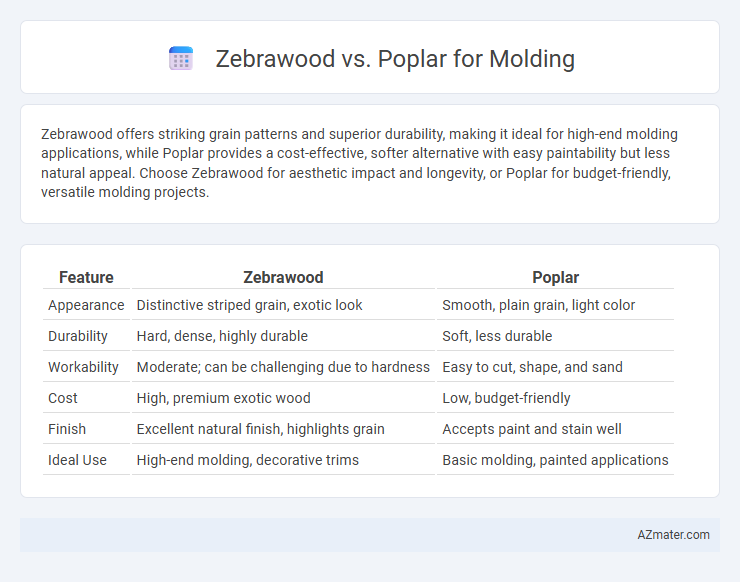Zebrawood offers striking grain patterns and superior durability, making it ideal for high-end molding applications, while Poplar provides a cost-effective, softer alternative with easy paintability but less natural appeal. Choose Zebrawood for aesthetic impact and longevity, or Poplar for budget-friendly, versatile molding projects.
Table of Comparison
| Feature | Zebrawood | Poplar |
|---|---|---|
| Appearance | Distinctive striped grain, exotic look | Smooth, plain grain, light color |
| Durability | Hard, dense, highly durable | Soft, less durable |
| Workability | Moderate; can be challenging due to hardness | Easy to cut, shape, and sand |
| Cost | High, premium exotic wood | Low, budget-friendly |
| Finish | Excellent natural finish, highlights grain | Accepts paint and stain well |
| Ideal Use | High-end molding, decorative trims | Basic molding, painted applications |
Introduction to Zebrawood and Poplar
Zebrawood, known for its striking dark stripes against a light tan background, offers exceptional durability and a unique aesthetic ideal for decorative molding. Poplar features a smooth texture and a light, creamy color, making it a versatile and affordable choice for painted or stained moldings. Both woods provide distinct benefits: Zebrawood excels in visual impact and strength, while Poplar is prized for ease of use and cost-effectiveness in molding applications.
Appearance and Grain Patterns
Zebrawood features striking, bold grain patterns with alternating dark and light stripes, offering a highly decorative and exotic appearance ideal for statement molding. Poplar displays a more subtle, straight grain with creamy white to light green hues, providing a smooth and uniform look suitable for painted or less prominent molding applications. The contrasting visual impact makes Zebrawood perfect for showcasing natural beauty, while Poplar excels in versatility and ease of finishing.
Hardness and Durability Comparison
Zebrawood exhibits a Janka hardness rating of approximately 1,160 lbf, making it significantly harder and more resistant to dents and wear compared to poplar, which has a Janka rating of about 540 lbf. The high density and interlocking grain of zebrawood contribute to superior durability, ideal for molding in high-traffic or impact-prone areas. Poplar's softer texture and moderate durability make it easier to work with but less suitable for applications requiring long-lasting structural integrity.
Workability and Machining
Zebrawood features a coarse texture and interlocking grain that can pose challenges during machining, requiring sharp tools and slower feed rates to prevent tear-out when used for molding. Poplar offers excellent workability with a straight grain and soft texture, making it easy to machine, shape, and finish, ideal for intricate molding profiles. The density of Zebrawood, typically around 830-950 kg/m3, contrasts with the lighter Poplar, approximately 430-510 kg/m3, impacting tool wear and machining speed.
Cost and Availability
Zebrawood is significantly more expensive than Poplar due to its exotic nature and limited availability, making it a costly choice for molding projects. Poplar is widely available and affordable, often chosen for budget-conscious woodworking because it is easy to source and process. The high cost and rarity of Zebrawood can delay project timelines, whereas Poplar ensures consistent supply and lower overall expenses.
Finishing and Staining Differences
Zebrawood features a striking natural grain with bold, contrasting stripes that respond well to clear finishes, enhancing its unique patterns, while Poplar has a more uniform, light color that absorbs stains unevenly and often requires a pre-conditioner for consistent results. Poplar's close grain allows for smooth sanding and better paint adhesion, but it lacks the vivid, natural aesthetic that Zebrawood's coarse, open grain provides after staining. Finishing Zebrawood typically highlights its exotic appearance with oil or lacquer, whereas Poplar is favored for painted moldings where stain color accuracy is less critical.
Weight and Density Factors
Zebrawood features a density of about 720 kg/m3, making it significantly heavier and denser than Poplar, which has a density around 450 kg/m3. This higher density in Zebrawood provides superior durability and a more substantial feel in molding applications, while Poplar's lighter weight allows for easier handling and installation. Weight considerations influence the choice between Zebrawood for robust, high-end moldings and Poplar for cost-effective, lightweight interior trim.
Environmental Impact and Sustainability
Zebrawood offers durability and a striking appearance but is often sourced from tropical rainforests, raising concerns about deforestation and biodiversity loss. Poplar, widely grown in managed plantations, provides a more sustainable choice due to its faster growth rate and lower impact on natural ecosystems. Choosing poplar for molding supports sustainable forestry practices and reduces environmental stress compared to the riskier extraction of exotic hardwoods like zebrawood.
Ideal Applications for Molding
Zebrawood's striking grain pattern and high durability make it ideal for decorative molding in upscale interiors, accentuating luxury spaces with a bold, exotic look. Poplar, with its smooth texture and ease of painting, suits functional molding applications where a prime surface for finishes is preferred, often used in trim and baseboards. Both woods offer versatility, but Zebrawood excels in visual impact while Poplar provides cost-effective, paint-friendly options for everyday moldings.
Choosing the Right Wood for Your Project
Zebrawood offers striking visual appeal with its bold striped grain, making it ideal for decorative molding that demands a unique and exotic look. Poplar is a cost-effective, lightweight option with a smooth texture and easy workability, suitable for painted or less intricate molding projects. Selecting the right wood depends on balancing aesthetics, budget, and the durability required for your molding application.

Infographic: Zebrawood vs Poplar for Molding
 azmater.com
azmater.com